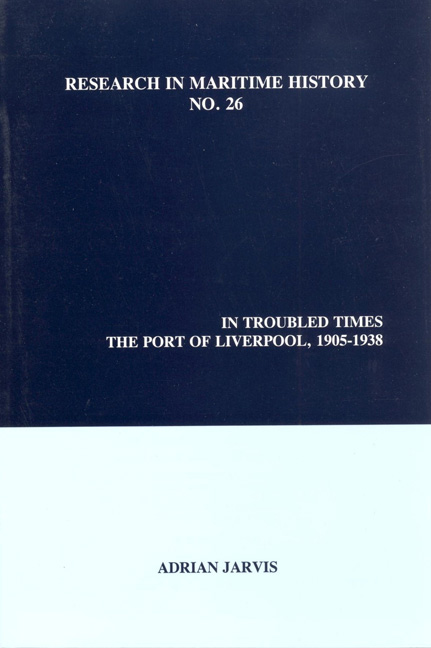Book contents
- Frontmatter
- Table of Contents
- List of Figures
- Foreword and Acknowledgements
- Conversion Factors for Imperial Measurements
- Introduction: The Port of Liverpool in 1905
- Chapter 1 The Port and Its Trade in 1905
- Chapter 2 Gladstone Dock
- Chapter 3 Not Before Time: The Board Keeps its Promise
- Chapter 4 Engineering, Management and Decision-making
- Chapter 5 Making the Customers Happy
- Chapter 6 Sand, Silt and Sewage: The Work of the Board's Dredgers
- Chapter 7 The Provision of Specialist Cargo Facilities
- Chapter 8 Into the Modern World?
- Conclusion: On the Eve of War
- Appendix: Port Efficiency: A Short Methodological Discourse
- A Note on Sources: Abbreviations
- Bibliography
- Index
Chapter 6 - Sand, Silt and Sewage: The Work of the Board's Dredgers
- Frontmatter
- Table of Contents
- List of Figures
- Foreword and Acknowledgements
- Conversion Factors for Imperial Measurements
- Introduction: The Port of Liverpool in 1905
- Chapter 1 The Port and Its Trade in 1905
- Chapter 2 Gladstone Dock
- Chapter 3 Not Before Time: The Board Keeps its Promise
- Chapter 4 Engineering, Management and Decision-making
- Chapter 5 Making the Customers Happy
- Chapter 6 Sand, Silt and Sewage: The Work of the Board's Dredgers
- Chapter 7 The Provision of Specialist Cargo Facilities
- Chapter 8 Into the Modern World?
- Conclusion: On the Eve of War
- Appendix: Port Efficiency: A Short Methodological Discourse
- A Note on Sources: Abbreviations
- Bibliography
- Index
Summary
From the opening of the Old Dock onwards, the port had to face the problems brought about by the very heavy silt burden carried by the water of the Mersey, a burden which it bore only when moving at more than about half a knot; if it flowed slower than that, it was deposited. The Old Dock had to be allowed to run dry periodically for “scuttling” - the manual removal of silt into barges - and dredging technology made rapid strides during the nineteenth century. The first steam dredger was put to work at Sunderland Harbour in 1797; the first steam bucket ladder dredger followed at Portsmouth in 1802 and was capable of raising about eighty tons per hour. Liverpool's first steam dredger, also of the bucket ladder type, followed in 1818 at a cost of £4294, plus £3900 for six hopper barges at £650 each. It could lift about forty-five tons per hour from a depth of about twenty feet.
The bucket ladder dredger was a rather clumsy tool for dredging in or close to passages and entrances, a task which was gradually appropriated by grab dredgers, of which Secunda, purchased in 1859, may have been the first in Liverpool. It certainly proved durable and was not scrapped until 1928. The bucket ladder dredger continued in use for general purposes but became more particularly associated with dredging rock and heavy materials in new construction works or the deepening of an existing dock. Its ability to work close to walls was improved by the introduction of the double side-ladder design, of which Tantalus (1900) was probably the first.
G.F. Lyster first saw a sand pump dredger (SPD) at work in the River Loire in 1876. While afterwards he conducted a small-scale experiment with one, he did not adopt the principle in earnest until he was forced to do so in 1890, when a large-scale experiment in dredging a breach in the bar began, leading eventually to the construction of three large SPDs and one gigantic one. From then on, the SPDs were mainly employed at the bar, in the main approach channels and at the Pluckington Bank.
- Type
- Chapter
- Information
- In Troubled TimesThe Port of Liverpool, 1905-1938, pp. 141 - 160Publisher: Liverpool University PressPrint publication year: 2003



